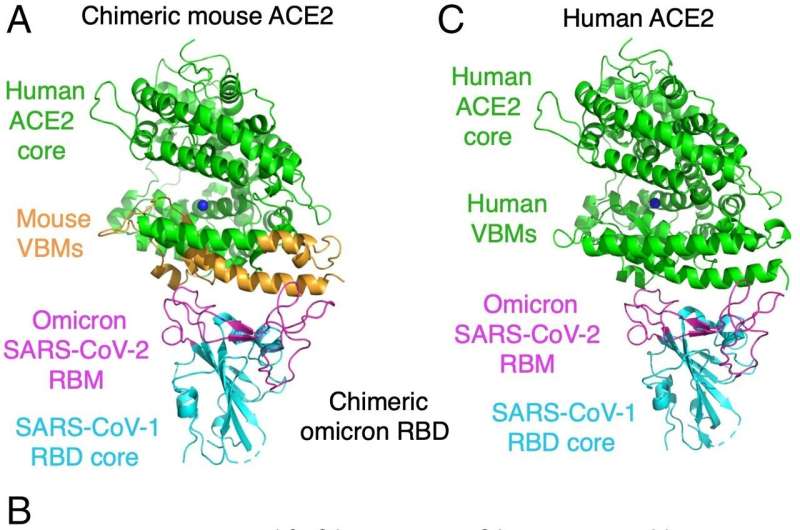Overall structures of chimeric omicron RBD complexed with chimeric mACE2 or hACE2. (A) Overall structure of chimeric omicron RBD complexed with chimeric mACE2. The chimeric omicron RBD contains the core structure (in cyan) from SARS-CoV-1 RBD and RBM (in magenta) from the omicron RBD (strain BA.2). The chimeric mACE2 contains the core structure (in green) from hACE2 and three VBMs (in orange) from mACE2. (B) Sequence alignment between hACE2 and mACE2 in three VBMs (shaded). The centers for hotspot-31 and hotspot-353 (i.e., residues 31 and 353, respectively) are both labeled in red. Residues that directly contact SARS-CoV-2 RBD are labeled in blue. Asterisks indicate positions that have a single, fully conserved residue. Colons indicate positions that have strongly conserved residues. Periods indicate positions that have weakly conserved residues. (C) Overall structure of chimeric omicron RBD complexed with hACE2. hACE2 is in green. Credit: Proceedings of the National Academy of Sciences (2022). DOI: 10.1073/pnas.2206509119
In a new study published in Proceedings of National Academy of Sciences researchers from the University of Minnesota Medical School and College of Biological Sciences provided new insights into the evolutionary origins of the COVID-19 omicron variant. Their findings suggest the omicron variant may have been transmitted from an animal species to humans.
An essential step in coronavirus infection occurs when spike protein binds to the host's receptor. After establishing consistent infections in the host, the spike protein becomes adapted to the host's receptor.
Through detailed structural biology analysis, researchers identified several mutations in the omicron spike protein that were uniquely adapted to the mouse receptor and incompatible with the human receptor. This suggests the omicron variant might not have originated from humans directly, and instead may have been transmitted from other animal species to humans.
"These omicron mutations are evolutionary traces left by the virus during its transmission from one animal species to another," said lead author Fang Li, Ph.D., an endowed professor of pharmacology at the U of M Medical School and director of the Center for Coronavirus Research. "Our detailed structural biology approach has successfully recovered these subtle yet unique evolutionary traces."
Researchers say the COVID-19 virus is capable of infecting many animal species—which is one of the main reasons why variants keep emerging. These findings also suggest that epidemic surveillance of rodents may be important for stopping new COVID-19 variants from emerging in the future.
"Animal to human transmission of coronaviruses will likely continue to threaten global health. It has been suggested that all coronaviruses circulating in humans came from animals," said Dr. Li. "I'm working with my colleagues to address current and potential future coronavirus pandemics by developing therapeutics targeting both human coronaviruses and animal coronaviruses."
More information: Wei Zhang et al, Structural basis for mouse receptor recognition by SARS-CoV-2 omicron variant, Proceedings of the National Academy of Sciences (2022). DOI: 10.1073/pnas.2206509119
Journal information: Proceedings of the National Academy of Sciences
Provided by University of Minnesota Medical School
























